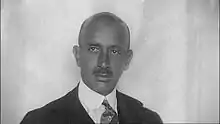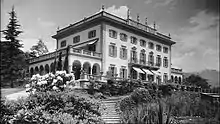Max Emden
Max James Emden (* Oktober 28,1874 in Hamburg; † June 26,1940 in Muralto, Kanton Tessin, Switzerland) was a German chemist, businessman, and art collector and owner of Isole di Brissago in Lago Maggiore since 1927.
Max Emden | |
|---|---|
| Born | October 28, 1874 Hamburg |
| Died | June 26, 1940 Muralto |
| Nationality | German |
| Occupation | art collector, businessman |
| Known for | art collection, retail magnate |

Life

Emden was the offspring of a long-established Jewish merchant family from Hamburg, the son of Jakob Emden and his wife Mathilde, (née Kann). The Emden family has been known to have lived in Hamburg since the 18th century, although the Emdens originally came from Frankfurt am Main. He converted to Protestantism. .
In Hamburg he attended Wilhelm-Gymnasium, graduating on September 7, 1893. Emden studied chemistry and minerology in Heidelberg, Genf, Zürich and Leipzig, where her acquired his doctorat in 1898. He married Concordia Gertrud Helene (née Sternberg) and serviced in the Leib-Husaren-Regiment in Danzig.
Emden had been a partner since 1904 in the family textile trading company M. J. Emden Söhne, and later became the sole owner. Founded in Hamburg in 1823, the company expanded under Emden into an internationally active trading company and department store group. Emden acquired land in the centers of major German and foreign cities, including Berlin, Potsdam, Chemnitz, Plauen, Stockholm, Munich and Budapest. The company was involved or operated well-known department stores such as KaDeWe in Berlin together with the main shareholder Adolf Jandorf, the Corvin department store in Budapest, the Allas department store in Stockholm, the Oberpollinger department store in Munich, the Poetsch department store in Hamburg and the Petersen department store in Wandsbek.
In 1906 Emden had the Hamburger Architect Wilhelm Fränkel build a home in Klein Flottbek for 200.000 mark On this spot today is a 26.000 m² private school.
At the age of almost 50, he sold most of his company properties to the Karstadt department store group (and others) concentrating on real estate and his foreign department stores.
In Ascona, Emden was a guest of Eduard von der Heydt on Monte Verità. In 1927 he acquired the Isole di Brissago in Lake Maggiore from owner Antoinette de Saint Léger, initially together with the cellist Bronisław Huberman, who soon withdrew.
He had the gardens renewed, the existing buildings largely removed and a palace-like villa built in the classicist style by the Berlin architect Alfred Breslauer. The 33 meter long Roman bath was decorated with the statue The Bathers by the sculptor Georg Wrba. The present botanical garden there is essentially his work. The female nude by the sculptor Werner Müller comes from the time of Emden. The Javanese by the sculptor Remo Rossi was added in 1950
Emden was a passionate golf and polo player. Ascona “owes the creation of its beautiful golf course” to his and von der Heydts' help. 107 / 5000
In 1928 in Hamburg-Rissen he financed the club house of the Falkenstein Golf Club "with a generous donation" . Until the 1930s, Emden owned the grounds of the Hamburg Polo Club in Klein Flottbek, which he had to sell to the city of Altona in 1935 for a low price.

Art collection
There was a major auction from the “Dr. Max Emden Collection“: paintings by German and French masters of the 19th century, furniture, carpets, bronzes, German silver, faience on Tuesday, June 9, 1931 (Catalog No. 13) - Berlin, 1931.
Persecuted in Germany because of his Jewish origins, from 1933 the millionaire lived mainly on his property in the canton of Ticino
In 1934 he acquired the citizenship of the municipality of Ronco, which is adjacent to the Brissago Islands. He received visits from numerous celebrities, such as the Aga Khan, the King of Siam and Erich Maria Remarque. Due to economic hardship, triggered by the measures directed against his assets in Germany, forced sales and "Aryanization" of properties and parts of the business, Emden began selling his works of art that had been brought to Switzerland in 1938, including several paintings by the Venetian Bernardo Bellotto, which were in the Adolf Hitler's collection and two paintings of which were in the possession of the Federal Republic of Germany for a long time and were not returned to the descendants of Emden until 2019 . This includes the picture Der Zwingergraben in Dresden.
Max Emden's Family
After Max Emden's sudden death in June 1940, his only son, Hans Erich Emden, became the sole heir to his father's property.
The Isole di Brissago archipelago in Lake Maggiore, which was orphaned and overgrown from 1941 onwards, when Emden's son, who had previously been expatriated from Germany as a Jew, finally managed to emigrate to Chile, belonged to the legacy. In this context, Hans Erich Emden apparently had several famous paintings, including Van Gogh's Flower Garden in Arles, as well as Renoir, Monet and others in the care of Swiss art dealers, who sold the works of art to various collectors, including the German-Swiss arms manufacturer Emil Georg Bührle, under unknown circumstances.[1] Hans Erich Emden had to give up the islands after the war and sold them in 1949 for around 600,000 francs to the canton of Ticino and the surrounding communities. The canton made the islands publicly accessible in 1950. The German Chancellor Konrad Adenauer was on the islands in the 1950s and found the view of Ascona “one of the most beautiful in Europe”.
Claims, Lawsuits and Restitutions
Several claims for Nazi looted art and forced sales have been filed. [2] Artists concerned include Bellotto[3][4] Canaletto and Claude Monet among others.[5]
On July 18, 2014, a path along the botanical garden in Hamburg-Klein Flottbek was named after Max Emden . The hiking trail runs between Hemmingstedter Weg and Hesten, between the botanical garden and the polo pitch and has a sign that indicates: “The path leads through the middle of Max Emden's former property, which he 'voluntarily' sold to the city of Hamburg in 1935. “ The main committee of the Altona district assembly approved the motion, pointing out that Max Emden “had to sell his property to the city of Altona for a low price in 1935” .[6]
Publications
- Über die Reduktionsprodukte der Phenylglyoxyldicarbonsäure. Inaugural-Dissertation der Hohen Philosophischen Fakultät der Universität Leipzig zur Erlangung der Doktorwürde. Druck von Metzger & Wittig, Leipzig 1898 (nicht im Katalog der Deutschen Nationalbibliothek enthalten).
- Hamburger Baukunst. Hamburg, November 1909 (nicht im Katalog der Deutschen Nationalbibliothek enthalten). (Digitalisat Universitätsbibliothek Hamburg)
- Der natürliche Arbeitstag : eine Rechenaufgabe. (Digitalisat Universitätsbibliothek Hamburg)
Film
On April 10, 2019, the documentary film "Life is an Art - The Max Emden Case" was premiered in Hamburg. The film works on the story of Max Emden and depicts the heirs' lavish struggle for restitution and justice against the authorities and private art collectors. Numerous experts comment on the subject of looted art and the works of art that were in the possession of Max Emden.[7][8]
Literature
- Ulrich Brömmling: Max Emden. Hamburger Kaufmann, Kaufhauserfinder, Ästhet und Mäzen. (Reihe: Mäzene für Wissenschaft, Neue Folge; Bd. 1). Wallstein, Göttingen 2020, ISBN 978-3-8353-3751-0.
- Ulrike Knöfel: Für ein Opfer zu mondän. In: Der Spiegel 38, 2017; online unter dem Titel Das Schicksal des Kaufhauskönigs Emden (noch nicht verlinkbar).
- Robert Landmann: Ascona – Monte Verità. Auf der Suche nach dem Paradies. Schultz, Berlin 1930; Huber, Frauenfeld 2000, ISBN 3-7193-1219-4.
- Ulrich Luckhardt, Uwe M. Schneede: Private Schätze. Über das Sammeln von Kunst in Hamburg bis 1933. Ausstellungskatalog. Hamburg 2001.
- Giuseppe Mondada: Die Brissago-Inseln in Vergangenheit und Gegenwart. Dadò, Brissago 1975.
- Eberhard Mros: Die Brissago-Inseln und ihre Umgebung im launischen Spiel der Zeiten. E. Mros, Ascona 2011, ISBN 978-3-9523402-1-9.
- Curt Riess: Ascona. Geschichte des seltsamsten Dorfes der Welt. Europa Verlag, Zürich 1964.
- Birgit Schwarz: Hitlers Museum. Böhlau, Wien 2004, ISBN 3-205-77054-4.
- Michael Sontheimer, Andreas Wassermann: Moral und Millionen. In: Der Spiegel. Nr. 45, 2006 (online – über die Kunstsammlung Emden).
- Carlo Speziali: 1885 – 1950 – 1985. Le isole di Brissago. Brissago 1985, speziell S. 48 ff.
- Francesco Welti: Der Kaufhaus-König und die Schöne im Tessin. Max Emden und die Brissago-Inseln. Huber, Frauenfeld 2010, ISBN 978-3-7193-1551-1.
- Ursula von Wiese: Vogel Phönix. Stationen meines Lebens. Klio, Bern 1994, ISBN 3-906635-02-3. (Autobiographie).
- Die Sammlung Dr. Max Emden. Auktion bei Ball-Graupe, Berlin, 9. Juni 1931 (Auktionskatalog); Universität Heidelberg (Digitalisat).
Weblinks
- Literature by and about Max Emden in the German National Library catalogue
- Englischer Beitrag über Max Emden und die Restitutionsbemühungen seines Enkels Juan Carlos Emden (PDF-Datei; 387 kB)
- Jens Meyer-Odewald: Der vergessene Hamburger Kaufhauskönig. In: Hamburger Abendblatt, 18. August 2014 online
- Seite des Hamburger Poloclubs, Geschichte des Clubs
- Lostart: Offizielle deutsche Seite der Koordinierungsstelle für Kulturgutverluste, Magdeburg, zu Raubkunst (looted art), hier: Jüdische Sammler und Kunsthändler (Opfer nationalsozialistischer Verfolgung und Enteignung) – Emden, Max James auf Stiftung Deutsches Zentrum Kulturgutverluste, abgerufen am 2. Februar 2017.
- Offizielle deutsche Seite des BADV – Bundesamt für zentrale Dienste und offene Vermögensfragen, hier: Bellotto Karlskirche in Wien aus Sammlung Emden
- Robert Schediwy: Der Schönheit geweiht. In: Wiener Zeitung vom 31. Juli 2010. (Über Max Emden und die Brissagoinseln.)
- Denise Chervet: Kunstsammler Max Emden. Er führte ein mondänes Leben im Tessin – bis die Nazis kamen. In: SRF, Religion und Kunst vom 25. November 2020.
References
- SPIEGEL, Ulrike Knöfel, DER. "Nazi-Deutschland: Das Schicksal des Kaufhauskönigs Emden". www.spiegel.de (in German). Archived from the original on 4 October 2007. Retrieved 2021-02-01.
- Advisory Commission on the return of cultural property seized as a result of Nazi persecution, especially Jewish property. "Explanatory statement on the recommendation of the Advisory Commission in the case of Dr. Max James Emden vs. The Federal Republic of Germany" (PDF). line feed character in
|title=at position 71 (help) - "Panel urges return of Hitler's Bellotto paintings to heirs of Jewish retail magnate". www.theartnewspaper.com. Retrieved 2021-02-01.
- Correspondent, David Sanderson, Arts. "Descendants of Jewish bon viveur Max Emden win right to sell art stolen by Nazis". ISSN 0140-0460. Retrieved 2021-02-01.
- Welle (www.dw.com), Deutsche. "Why the origins of artworks are so important | DW | 11.04.2019". DW.COM. Retrieved 2021-02-01.
- "Drucksache" (in German). Retrieved 2017-09-20.
- Woeller, Marcus (2019-04-24). "„Der Fall Max Emden" ist ein Film über Deutschlands Schande". DIE WELT. Retrieved 2021-02-01.
- Welle (www.dw.com), Deutsche. "Brisanter Dokumentarfilm: "Auch Leben ist eine Kunst - Der Fall Max Emden" | DW | 10.04.2019". DW.COM (in German). Retrieved 2021-02-01.
[[Category:1940 deaths]] [[Category:1874 births]] [[Category:People from Brissago]] [[Category:Swiss people]] [[Category:Emigrants from Nazi Germany]] [[Category:20th-century businesspeople]] [[Category:Businesspeople from Hamburg]] [[Category:Patrons of the arts]]